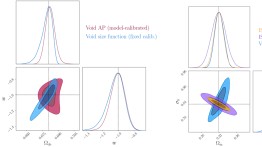Assistant Professor Alice Pisani Co-Published in The Astronomy & Astrophysics Journal
POSTED ON: August 3, 2023

Figure 6 from publication.
Assistant Professor of Physics, Alice Pisani, has co-published in the Astronomy & Astrophysics Journal (Vol. 667, November 2022 Issue). The publication is on, “Euclid: Cosmological forecasts from the void size function.”
You can read more about the research here.
Abstract
The Euclid mission – with its spectroscopic galaxy survey covering a sky area over 15 000 deg2 in the redshift range 0.9 < z < 1.8 – will provide a sample of tens of thousands of cosmic voids. This paper thoroughly explores for the first time the constraining power of the void size function on the properties of dark energy (DE) from a survey mock catalogue, the official Euclid Flagship simulation. We identified voids in the Flagship light-cone, which closely matches the features of the upcoming Euclid spectroscopic data set. We modelled the void size function considering a state-of-the art methodology: we relied on the volume-conserving (Vdn) model, a modification of the popular Sheth & van de Weygaert model for void number counts, extended by means of a linear function of the large-scale galaxy bias. We found an excellent agreement between model predictions and measured mock void number counts. We computed updated forecasts for the Euclid mission on DE from the void size function and provided reliable void number estimates to serve as a basis for further forecasts of cosmological applications using voids. We analysed two different cosmological models for DE: the first described by a constant DE equation of state parameter, w, and the second by a dynamic equation of state with coefficients w0 and wa. We forecast 1σ errors on w lower than 10% and we estimated an expected figure of merit (FoM) for the dynamical DE scenario FoMw0, wa = 17 when considering only the neutrino mass as additional free parameter of the model. The analysis is based on conservative assumptions to ensure full robustness, and is a pathfinder for future enhancements of the technique. Our results showcase the impressive constraining power of the void size function from the Euclid spectroscopic sample, both as a stand-alone probe, and to be combined with other Euclid cosmological probes.




